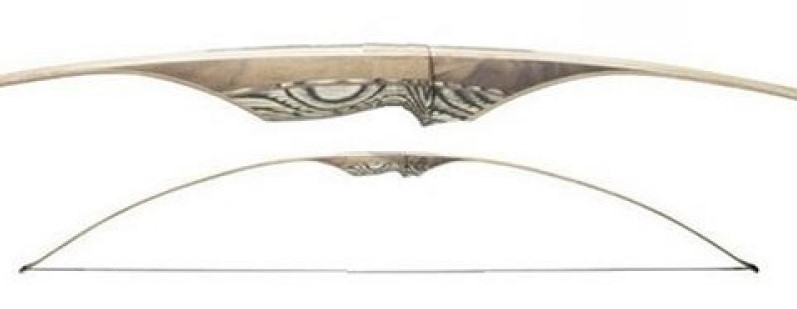- Screen Colours:
- Normal
- Black & Yellow
English Longbows
The most famous bow in the world is the English Longbow. With such a history it is no surprise that the longbow is still a popular choice for archers today. Although today’s bows out perform the longbow in every department, there is no true substitute for it.
You do not own a longbow because of it is accuracy or ease of use. You own a longbow because of what it is; A beautiful, authentic piece of history. Arguably the most popular of the traditional bow types, these bows are based on those used by English archers at Agincourt etc.
Modern versions are constructed from a number of laminations, with draw weight usually up to around 60lb, so much lighter than the 150lb bows found on the Mary Rose.
As with Recurve and Compound bows, Longbows are well supported at most competitive shoots, both target and field. Only wooden arrows are permitted as with self-bows. No modern materials with these babies. Feather fletching’s are used on the arrows to assist with clearance as the arrow passes the bow.
Neither longbows nor self-bows have any form of arrow rest, the arrow is shot off the hand, so archers usually wear a glove on their bow hand.

Flatbows
A modern longbow may be the best way to describe this type of bow. In fact, ‘Longbow’ is its common name if you happen to live across the pond in the USA.
These bows are a bit of a hybrid. They’re a sort of amalgam of an English Longbow and some of the bows used by Native American Indians. They’re called flatbows in the UK as they clearly aren’t longbows and the limbs have a flat cross section (unlike Longbows which have a D shaped cross- section). A flat bow is a good compromise of tradition and modern materials.
The utilization of modern materials is what differentiates it from its ancestor. Its fibreglass outer laminates give it increased flexibility and durability. It also has a small cut-away to shoot the arrow from the shelf, rather than off the hand.
There is no recurve to the limb tips, and having one would exclude the bow from the flatbow class at most competitions. The handle of the bow has an arrow “shelf” as can b e seen in the close-up picture. The arrow rests on this whilst the bow is drawn and aimed. This is known as shooting “Off the shelf”.
e seen in the close-up picture. The arrow rests on this whilst the bow is drawn and aimed. This is known as shooting “Off the shelf”.
Again, as it’s classed as a traditional bow, wooden arrows are preferred, but some archers do shoot aluminium or even carbon arrows from them.
They are more efficient and accurate than longbows and as with all bow types, those that shoot them love them.
Horse Bows
Made famous by the mounted warriors of ancient times, these short, fast, flexible bows are hugely enjoyable. Their beautiful, flowing forms and simplistic nature appeal to a broad range of archers. Both experienced and novice alike. Of course, designed to be shot from the back of a horse.
Generally based on the design of the Mongol bows, these bows are very short at around 50”. Traditional versions would be backed with animal sinew, but more modern materials are used in most modern versions.
As with self and longbows there is normally no shelf on Horse bows and arrows are shot off the hand. The most traditional horseback archers will use a thumb ring to draw the bow.
Recurve Field Bows
Designed for Field Archery these bows are generally shorter than full recurves with overall lengths typically between 54” and 62” to make them more manageable in woods. They are still recurve bows though, as can be seen by the way the limbs curve forward toward the tips.
These bows come in both take down (3 piece) and one  piece forms. The take down versions can come in ILF format, but generally not.
piece forms. The take down versions can come in ILF format, but generally not.
A lot of archers who shoot these bows will shoot them off the shelf with wooden arrows, but most can be fitted with arrow rests, and shooting carbon or aluminium arrows is not uncommon.
Being recurve bows, they deliver the power to the arrow much more efficiently and are more accurate than longbows and flatbows.
Self-Bo w
w
The most basic bow it’s possible to get and the first of the “traditional” bow types. If you ever made a bow from the branch of a tree when you were a child, that would have been a self-bow.
Often referred to as a primitive bow, self-bows are made from a single piece of wood. If you like your archery at its most basic, this is the bow for you. Careful though; accuracy is something to dream of if you shoot this bow type. They can also be extremely fragile.